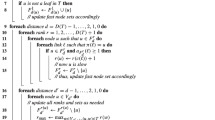Abstract
Broadcast data delivery is encountered in many applications where there is a need to disseminate information to a large user community in a wireless asymmetric communication environment. In this paper, we consider the problem of scheduling the data broadcast such that average response time experienced by the users is low. In a push-based system, where the users cannot place requests directly to the server and the broadcast schedule should be determined based solely on the access probabilities, we formulate a deterministic dynamic optimization problem, the solution of which provides the optimal broadcast schedule. Properties of the optimal solution are obtained and then we propose a suboptimal dynamic policy which achieves average response time close to the lower bound. The policy has low complexity, it is adaptive to changing access statistics, and is easily generalizable to multiple broadcast channels. In a pull-based system where the users may place requests about information items directly to the server, the scheduling can be based on the number of pending requests for each item. Suboptimal policies with good performance are obtained in this case as well. Finally, it is demonstrated by a numerical study that as the request generation rate increases, the achievable performance of the pull- and push-based systems becomes almost identical.
Similar content being viewed by others
References
S. Acharya, R. Alonso, M. Franklin and S. Zdonik, Broadcast disks: Data management for asymmetric communication environments, Technical Report CS–94–43, Department of Computer Science, Brown University (October 1994).
S. Acharya, M. Franklin and S. Zdonik, Dissemination-based data delivery using broadcast disks, IEEE Personal Communications 2(6) (December 1995) 50–60.
S. Acharya, M. Franklin and S. Zdonik, Prefetching from a broadcast disk, in: Proc. of 12th International Conf. Data Eng., New Orleans, LA (February 1996).
M.H. Ammar, Response time in a teletext system: An individual user's perspective, IEEE Transaction on Communications 35(11) (November 1987) 1159–1170.
M.H. Ammar and J.W. Wong, The design of teletext broadcast cycles, Performance Evaluation 5(4) (December 1985) 235–242.
M.H. Ammar and J.W. Wong, On the optimality of cyclic transmission in teletext systems, IEEE Transaction on Communications 35(1) (January 1987) 68–73.
D.P. Bertsekas, Dynamic Programming: Deterministic and Stochastic Models (Prentice-Hall, Englewood Cliffs, NJ, 1987).
T. Chiueh, Scheduling for broadcast-based file systems, in: Proc. of the Mobidata Workshop, Rutgers University, NJ (November 1994).
H.D. Dykeman, M.H. Ammar and J.W.Wong, Scheduling algorithms for videotex system under broadcast delivery, in: Proceedings of ICC '86 (1986) pp. 1847–1851.
J. Gecsei, The Architecture of Videotex Systems (Prentice-Hall, Englewood Cliffs, NJ, 1983).
D.K. Gifford, Polychannel systems for mass digital communication, Communications of the ACM 33(2) (February 1990) 141–151.
T. Imielinski and B. Badrinath, Mobile wireless computing: Solutions and challenges in data management, Technical Report, Department of Computer Science, Rutgers University, NJ (1992).
T. Imielinski, S. Viswanathan and B. Badrinath, Energy efficient indexing on air, in: Proc. of ACM SIGMOD Conf. (May 1994) pp. 25–36.
R. Jain and J. Werth, Airdisks and airRAID: Modelling and scheduling periodic wireless data broadcast, Dimacs Technical Report 95–11, Department of Computer Science, Rutger University (May 1995).
D.E. Knuth, The Art of Computer Programming, Vol. 3 (Addison-Wesley, Reading, MA, 2nd ed., 1981).
B. Oki, M. Pfluegl, A. Siegel and D. Skeen, The information bus - an architecture for extensible distributed systems, in: Proc. 14th SOSP (December 1993).
S.M. Ross, Introduction to Stochastic Dynamic Programming (Academic Press, New York, 1983).
S. Shekhar and D. Liu, Genesis and advanced traveler information systems ATIS: Killer applications for mobile computing, in: MOBIDATA Workshop (1994).
C.-J. Su, L. Tassiulas and V. Tsotras, A new method to design broadcast schedules in a wireless communication environment, Technical Report, Institute for Systems Research, University of Maryland, College Park, MD (1996).
L. Tassiulas and C.-J. Su, Optimal memory management strategies for a mobile user in a broadcast data delivery system, IEEE Journal of Selected Areas in Communications 15(7), Special Issue on Networking and Performance Issues of Personal Mobile Communications (September 1997) 1226–1238.
J.W. Wong, Broadcast delivery, Proceedings of the IEEE 76(12) (December 1988) 1566–1577.
S. Zdonik, S. Acharya, R. Alonso and M. Franklin, Are ‘Disks in the air’ just pie in the sky?, in: IEEE Workshop on Mobile Computing Systems and Applications (December 1994).
G.K. Zipf, Human Behaviour and the Principle of Least Effort (Addison-Wesley, Reading, MA, 1949).
Author information
Authors and Affiliations
Rights and permissions
About this article
Cite this article
Su, CJ., Tassiulas, L. & Tsotras, V.J. Broadcast scheduling for information distribution. Wireless Networks 5, 137–147 (1999). https://doi.org/10.1023/A:1019134607998
Issue Date:
DOI: https://doi.org/10.1023/A:1019134607998




